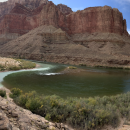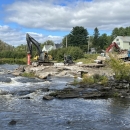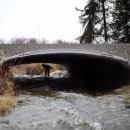States
ArizonaThis project will replace a culvert that prevents fish from moving freely on Crooked Creek in Arizona. Crooked Creek contains one of only 17 populations of threatened Apache trout, and this project will allow Apache trout to move freely within their habitat. Other species that will benefit include speckled dace and desert suckers. As climate change climate change
Climate change includes both global warming driven by human-induced emissions of greenhouse gases and the resulting large-scale shifts in weather patterns. Though there have been previous periods of climatic change, since the mid-20th century humans have had an unprecedented impact on Earth's climate system and caused change on a global scale.
Learn more about climate change impacts freshwater streams, this habitat will be stable for Apache trout in the future, supporting its need for restoration. This project also supports goals and objectives from the White Mountain Apache Tribe Native Fishes Management Plan to conserve, maintain, and enhance existing native fish populations and their habitats. Each thriving native fish population is culturally and commercially important to the Tribe.
Project Quick Facts:
| Project Status | In Development |
| Location | AZ, Apache County |
| NFPP Project Funding | $325,000 |
| Restoration Techniques | Culvert Replacement |
| Accomplishments | 8 Stream Miles Reopened |
| Project Partner Lead | Arizona Fish and Wildlife Conservation Office |
The National Fish Passage Program combines technical expertise with a track record of success.
Implemented primarily through the Service's Fish and Wildlife Conservation Offices, the National Fish Passage Program provides financial and technical assistance to partners across the country. Since 1999, the program has worked with over 2,000 local communities, Tribes, and private landowners to remove or bypass over 3,400 barriers to fish passage fish passage
Fish passage is the ability of fish or other aquatic species to move freely throughout their life to find food, reproduce, and complete their natural migration cycles. Millions of barriers to fish passage across the country are fragmenting habitat and leading to species declines. The U.S. Fish and Wildlife Service's National Fish Passage Program is working to reconnect watersheds to benefit both wildlife and people.
Learn more about fish passage and reopen access to over 61,000 miles of upstream habitat for fish and other animals. Staff have expertise in fish migration and biology as well as financial, engineering, and planning assistance to communities, Tribes, and landowners to help them remove barriers and restore rivers for the benefit both fish and people.
Fish passage project proposals can be initiated by any individual, organization, government, or agency. However, proposals must be submitted and completed in cooperation with a Fish and Wildlife Conservation Office. (Please note that fish passage projects being used for federal or state compensatory mitigation or required by existing federal or state regulatory programs are not eligible for funding through the National Fish Passage Program.)
CONTACT A FISH PASSAGE COORDINATOR IN YOUR AREA TO GET STARTED.




